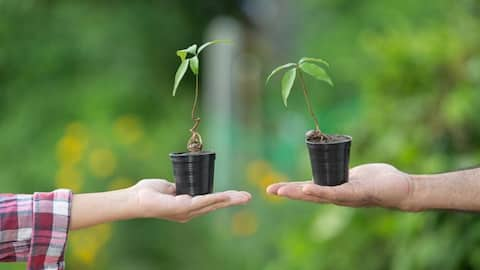On camera: Plants talk using smell; video goes viral
What's the story
A team of Japanese scientists from Saitama University has made a groundbreaking discovery by capturing real-time footage of plants communicating with each other. The video, as reported by Science Alert, shows plants releasing a fine mist of airborne compounds to warn nearby plants of potential dangers. This mist carries smell. Molecular biologist Masatsugu Toyota and his team have uncovered the fascinating details of when, where, and how plants respond to airborne "warning messages" from their threatened neighbors.
Twitter Post
Check out this video!
If #plants could talk, they’d do so thru chemical signals about predators (aphids, caterpillars, gardeners with shears/pesticides…). Plants CAN talk (which we’ve known), but molecular biologists at Saitama University in Japan caught it 1st on film. https://t.co/44gXzMerK5 pic.twitter.com/DcLAlV1iti
— HoneyGirlGrows (@HoneyGirlGrows) January 20, 2024
VOCs
Role of volatile organic compounds (VOCs)
The researchers, including PhD student Yuri Aratani and postdoctoral researcher Takuya Uemura, studied how undamaged plants reacted to volatile organic compounds (VOCs) which are a class of odor molecules released by neighboring plants under threat, such as those damaged by insects. "Plants perceive VOCs released by mechanically or herbivore-damaged neighboring plants and induce various defense responses. Such interplant communication protects plants from environmental threats," the authors explained in their study published in the journal Nature Communications.
Capture
Capturing plant communication with calcium signaling
To capture this communication, the scientists used an air pump connected to containers of leaves and caterpillars. They allowed caterpillars to feed on leaves from tomato plants and Arabidopsis thaliana, a common mustard family weed. A biosensor emitting a green glow was added to detect calcium ions, a signaling mechanism also used by human cells for communication. The footage reveals undamaged plants receiving messages from their injured neighbors and responding with bursts of calcium signaling that spread across their leaves.
Network
Unveiling the ethereal communication network
The team's analysis of airborne compounds identified two specific compounds, Z-3-HAL and E-2-HAL, that induced calcium signals in Arabidopsis. "This ethereal communication network, hidden from our view, plays a pivotal role in safeguarding neighboring plants from imminent threats in a timely manner," stated Toyota. Similarly, the researchers measured calcium signals released by Mimosa pudica (touch-me-not) plants, known for their quick leaf movements in response to touch as a defensive mechanism against predators.
Ecosystem
Role of plant communication in ecosystems
Gaining an understanding of plant communication is essential to understanding ecological dynamics. It clarifies how plant communities react to environmental stressors and how they can withstand disruptions like pests and climate change. Agriculture, forestry, and conservation activities may all benefit greatly from this information because it can direct actions that promote good plant communication and, consequently, ecosystem health.
